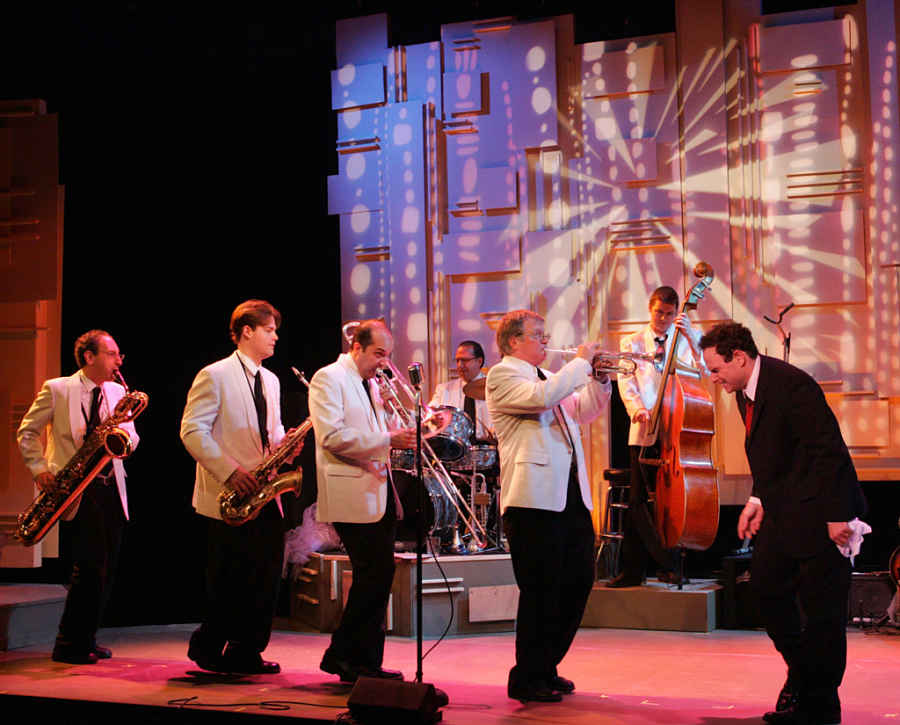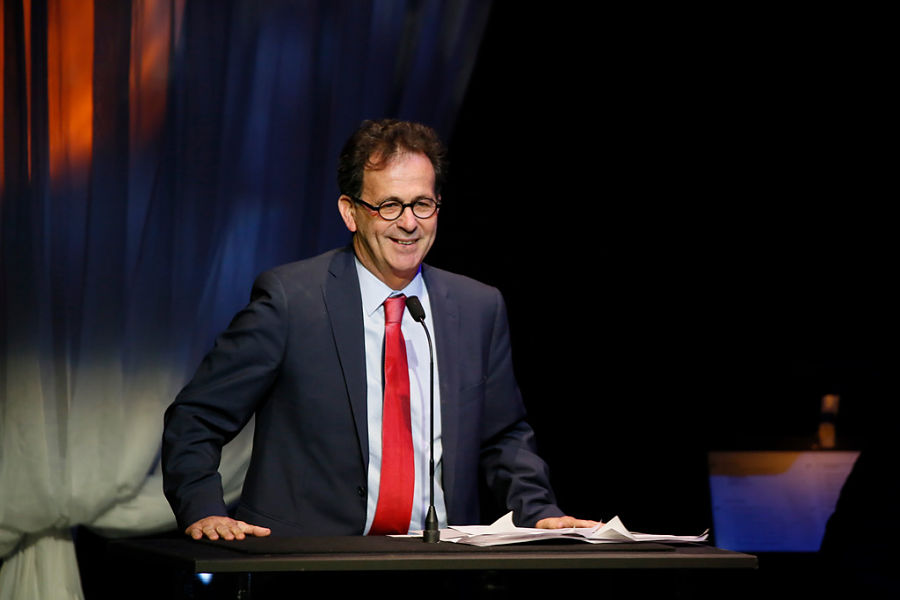Around Los Angeles, Steven Leigh Morris needs no introduction. He’s been a theatre critic and advocacy journalist here for more than three decades. For most of that time, he wrote for the alternative newspaper LA Weekly, and for 15 of those years, he headed that paper’s theatre section. He chaired the jury for the Pulitzer Prize for Drama in 2012 and served on it in 2011.
Then, in part in response to the downsizing of reviews and his responsibilities at the Weekly, Morris launched Stage Raw, a nonprofit website devoted to theatre reviews, especially intimate theatre, as well as the cultural beat in the City of Angels, on the Ides of March, 2014. (That’s where—full disclosure—he has been my editor.) In addition, when the LA Weekly Theater Awards for intimate theatre were discontinued after 35 years, Steven stepped in and continued the tradition under the Stage Raw banner, hosting the first annual Stage Raw Los Angeles Theater Awards in April of this year.
Perhaps unsurprisingly, then, the recent news that Morris was appointed the new executive director of LA STAGE Alliance (LASA), the acknowledged lobbying voice for theatre in L.A., was greeted enthusiastically by nearly everyone. For those outside L.A., this story might give you a sense of Morris’s unique role here: When playwright John Pollono was first starting out in L.A., he, his wife, and some friends created a theatre company and “were desperate to get coverage” for a night of one-acts, he told me. Somehow Pollono got Morris’s number, called it, and left a voicemail pitching him very hard to come—about how the critic’s presence would help create awarness of the fledgling group, how the group would feel privileged just to have him in the audience. Morris showed up.
Now Morris is about to show up for a new role: Today he starts at LASA. What are his plans? We met in the foothills of the majestic San Bernardino Mountains—a rugged wilderness that often figures in his writings as a marked contrast to the urban cityscape located some 60 miles to the east.
You’ve been a writer and journalist all your life. Why did you apply for the position of a nonprofit executive director?
I think an organization like LASA gives me an opportunity to do something of service that wasn’t afforded by my position as a journalist at either LA Weekly or Stage Raw. I think I was hired because the LASA board wants the organization to be in a leadership role.
There are many different voices you need to represent. Are you advocating for large or small theatres? Are you advocating for producers or actors?
I’m advocating for the health of theatres, large and small. I think our city would be totally impoverished without the Center Theatre Group, the Geffen Playhouse, Theatricum Botanicum, and others. Those are our mid-sized and larger theatres. We would be in a swamp without those theatres.
At the same time we would be equally impoverished without our 99-seat theatres, which are under fewer financial constraints and ergo can do more risky work. Trevor, which played at Circle X Theater, had just about the finest actors you’re going to find anywhere, including Laurie Metcalf. They were performing under the [Equity Waiver] 99-Seat Plan. That’s what that plan has allowed for.

We have to stop looking at these as divides of large and small, and look at them as symbiotic—how larger theatres actually help our smaller theatres and vice versa. The audiences may not go to both in equal measure, but for the vitality of the cultural ecology they both have to be around. It’s the diversity argument. It’s not just ethnic diversity, it’s also artistic diversity. That’s what makes a healthy ecosystem.
Most of our theatres are invisible even to the average Angeleno, except for the largest of them. What can LASA do to change that?
I had a student who lived in and commuted from North Hollywood and had no idea how many theatres were in her own district. She’d drive up and down Lankershim Blvd., which is essentially Theater Row for the Valley. So I get the significance of your question.
When some of the larger institutions and museums have a show, you see the banners down Wilshire Blvd. You can’t miss them. It’s available to anyone who drives—and here in Los Angeles, that’s everyone. I have not seen banners on the streets for companies such as Deaf West, which has now taken two shows to Broadway. When they do a play, I don’t see any kind of civic support. I think that’s definitely something we can talk about with the city officials: just making theatre visible. These are small theatres, and maybe the city figures that it is not worth the investment. Maybe that’s an argument that needs to be countered: that actually, when it’s a high-caliber production that runs a long time, it is worth the investment.
We need to get recognition of the theatre art beyond the theatre community, so that people who live in Los Angeles understand really clearly that if they haven’t seen a play, in a large or a small theatre, they haven’t really lived in Los Angeles.
Do you think it’s possible to convince people from New York and elsewhere to come to Los Angeles to see theatre?
Yes. I think they have to be guided in the right direction, but that’s essentially marketing . New York does that really, really well, and Chicago has done that really, really well. We don’t do it that well, and it’s time for that to change.
When you talk about bringing tourists to Los Angeles theatre, that production of Trevor is something that we, as a civic entity, should be completely comfortable saying to the tourists, “See this.” It was a top-caliber production.
But I wouldn’t discriminate based on the size of the theatre. Sometimes a revival of Annie can be wildly popular and set a 14-year-old on the road to becoming part of the theatre audience. That’s no less legitimate than The Day Shall Declare It or any kind of immersive theatre.
For years, you have been associated with the 99-seat theatres—those are the only theatres the Weekly awards recognized, for instance. At LASA, you represent all theatres. What are the challenges of representing both?
I don’t think of it as a challenge at all. Backstage at the Ovation Awards Ceremony, I had a very amiable conversation with Michael Ritchie, who heads up Center Theatre Group, and we talked about that issue. He referred to what he admitted was his spotty record involving local theatres; he said that Center Theatre Group is now working on deepening their commitment to the smaller theatre community. I find that very gratifying to see that he’s moving in that direction.
He’s been at Center Theatre Group for 10 years.
It takes a while for people who are not from here to absorb the complexities of what the scene is like. There are a lot of assumptions that come from other places. I think you have to live here for a while to make sense of this mess, this geographic sprawl, that we live in. Los Angeles is a series of neighborhoods and communities. The Hollywood Fringe Festival is particularly successful because it isolates a festival into a very specific geographic corner, a one-mile square block. And I think part of its success is attributable to that, its being tethered to a neighborhood. I see that as a potential fix to the geographic issues: if we could encourage some of our best theatres to gravitate to certain neighborhoods. That has worked in other cities, and I think that can work for us, too.
Of course, as property becomes more valuable, theatres—especially in that one-mile square block in Hollywood—are often priced out.
Yep. Real estate in San Francisco, Los Angeles, and San Diego is really becoming the major challenge. I think our community flourished because work could be done so easily, and the reason it could be done so easily is a combination of the 99-seat plan and relatively low real estate prices. And now both of those are under siege.
Can LASA facilitate funding for the community?
It has to. It not only can, it must.
To what extent?
Ask me that in a year.
Can LASA facilitate a mechanism to help intimate-theatre shows more easily move into larger venues and longer runs in Los Angeles? That’s one way of creating the visibility you speak about. Every show that moves to a larger L.A. theatre becomes an ad for the small theatre that spawned it.
If Michael Ritchie is an example, the larger theaters are starting to pay closer attention now than they were before. It may be a viable economic strategy for these theatres to finally understand that the best work in our smaller theatres is worth transferring. That has been a model in New York for decades. Now it’s starting to catch on here. I think there was more of a divide 20 years ago in that regard; I think the relationship between larger and smaller theaters is a little more fluid than it used to be. The smaller theatres are being scrappier, knowing the artistic directors of the larger theatres, and pitching their stuff.
Is this an area where LASA can take an active role, since they represent both theatre sizes?
Absolutely.
But it hasn’t in the past.
We can certainly help make introductions—point out to larger theatres around town the shows that would do well for them. Not all shows are meant to be transferred; some shows are just meant to be in a small theatre, and they would be diminished in a larger theatre. Others make the leap very well.

Is it a marketing issue that a lot of folks in L.A. don’t understand that productions in the smaller venues like Boston Court, Antaeus, or the Fountain are just as fully realized as the productions in much larger and better known venues like the Ahmanson, Geffen, and Taper?
I think there’s a learning curve that’s taken four decades. A theatre such as Boston Court has a very loyal following; their audience goes to that theatre because they expect to see plays they will not see at some of the larger venues, and they understand exactly the aesthetics of that theatre. And the work at the Fountain Theater is very, very different from that of Boston Court; it’s much more traditional in its orientation. The storylines—with some exceptions—tend to be much more linear. So when you talk about small theatres and large theatres, there are so many divides.
This is so complicated, which is why I am loathe to distinguish between the virtues and the vices of large theatres and small theatres. Maybe it’s age, but I’m just coming to see that theatre is theatre and it takes many, many shapes and sizes. And the reasons for doing it are as varied as the appearances it takes. It’s very hard, and almost foolish, to draw divides and try to segment the kinds of theatre we have.
Now that you are executive director at LASA, will Stage Raw lose your journalist’s voice?
I don’t know about that. I’m not going to be involved in the day-to-day operations anymore; I’ll watch it from a distance. Depending on how LASA feels about it, I might want to contribute an occasional piece.
You are also one of the major theatre critics in the city going back three decades. What happens to that voice?
I’m not going to be reviewing shows. But am I going to be writing about productions? Probably. Am I going to be putting them in a larger sociopolitical context? Probably.
How about the Stage Raw Awards—now that you’re running the organization that does the Ovation Awards, is there going to be a second annual Stage Raw Award Ceremony next April?
I hope so. I won’t be producing them, but I will certainly help to ensure they go on. But, as I say, from a distance.
You’ve often used metaphors of climate change in your writing. But climate change is all about tipping points and points of no return. What is the tipping point with the theatre?
People will always do theatre; they always have. I’ve been part of and interested in this scene for so many years. Not all the work is great. It’s often a real test of patience and fortitude to sit through some of these productions. But I keep coming back because often there is a caliber of production and a purity of motive and an intelligence and an exhibition of craft that is so engaging that I find myself rattled on leaving the theatre, thinking, That had so much impact! It might not happen again for another month, even though I see three to four shows a week. But that’s enough to keep coming back.
For me the tipping point that I would consider tragic would be if somehow those highlights I see stopped coming because theatre quality was impeded for whatever reason—whether it’s high rents or a change in the Equity 99-seat plan or anything else. Los Angeles is a great theatre town. And I would like to see that continue.
Kevin Delin writes for Stage Raw, Footlights, and Script. You can follow him on Twitter at @kdelin.


